On the subject of coloring, I've already mentioned how to avoid it finishing defects. I will now present the solutions for staining wood - the wood stains, as they are commonly called - and what you need to do to get the desired effect.
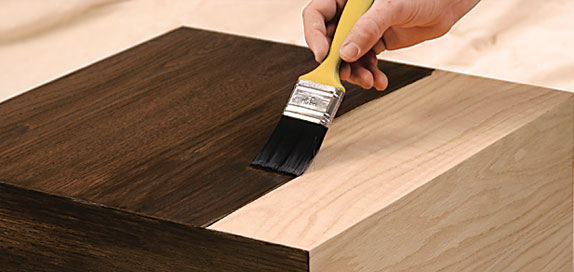
photo source: ublog.live
Why we color wood
Staining can serve several purposes: to beautify the wood, to bring out its natural design, to mark pores, to even out its natural color, to hide defects, to protect it. These goals cannot be achieved with the same coloring material. The range of coloring products is very diverse, but I will try to tell you something about the most commonly used.
At the risk of repeating myself, I'll say again that the most important stage of finishing is white grinding. Good and correct sanding greatly reduces the risk of staining defects.
Wood staining solutions
Wood staining is done with solutions of dyes or pigments in water or organic solvents, simple or with added resins and other materials. The difference between colorants and pigments is the dissolution in solvent (water or organic solvents). The colorant dissolves in the solvent, the pigment does not. The colorant forms a uniform coloring solution, whereas the pigment forms a dispersion in the solvent. This means that small pigment particles float in the solvent.
The solution will penetrate into the wood with the solvent and bring out the natural pattern of the wood. The dispersion will penetrate the wood less, the particles remain on the surface and produce a smoothing effect. In conclusion, if you want to bring out the pattern of the wood, use stains. Pigments are used if the aim is to make the color more uniform, which will also result in a blurring of the natural wood design.
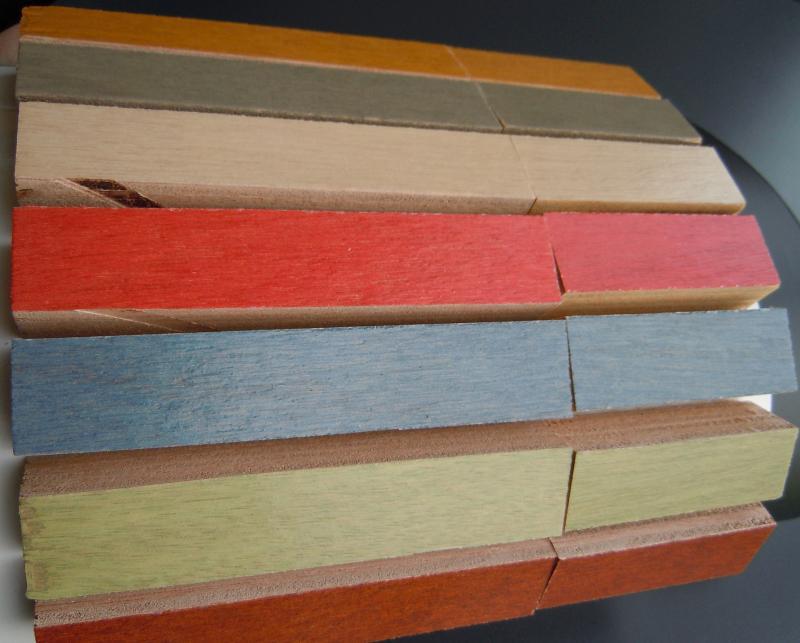
photo source: edilizianews.it
Staining wood with pores is different from staining resinous woods
Not all wood species behave the same when colored. I said in an article about staining with P43, that this solution is perfect for staining oak, but it stains beech very badly. The same goes for other bleaches. For example, staining solutions that mark the wood pores will be perfect for staining wood with pores (oak, ash, maple), but totally unsuitable for resinous wood (wood that has no pores). There will be a big difference between the two types of wood after staining with the same solution.
Therefore, when a customer wants a certain color that he has seen on a sample of oak and wants the same thing on fir wood, he must know that he will not get the same effect, even if the color is identical. The effect will be different and the customer's perception will be that it is a different color.
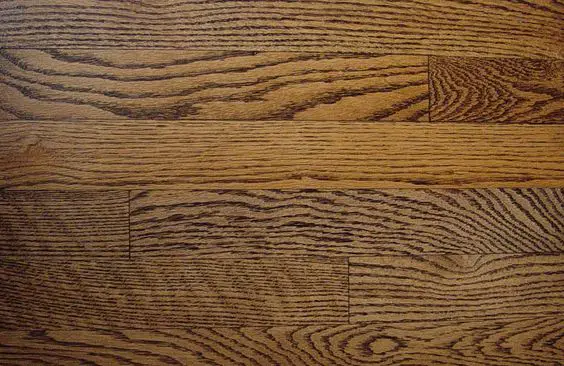
photo source: victorinfloorfinishing.com
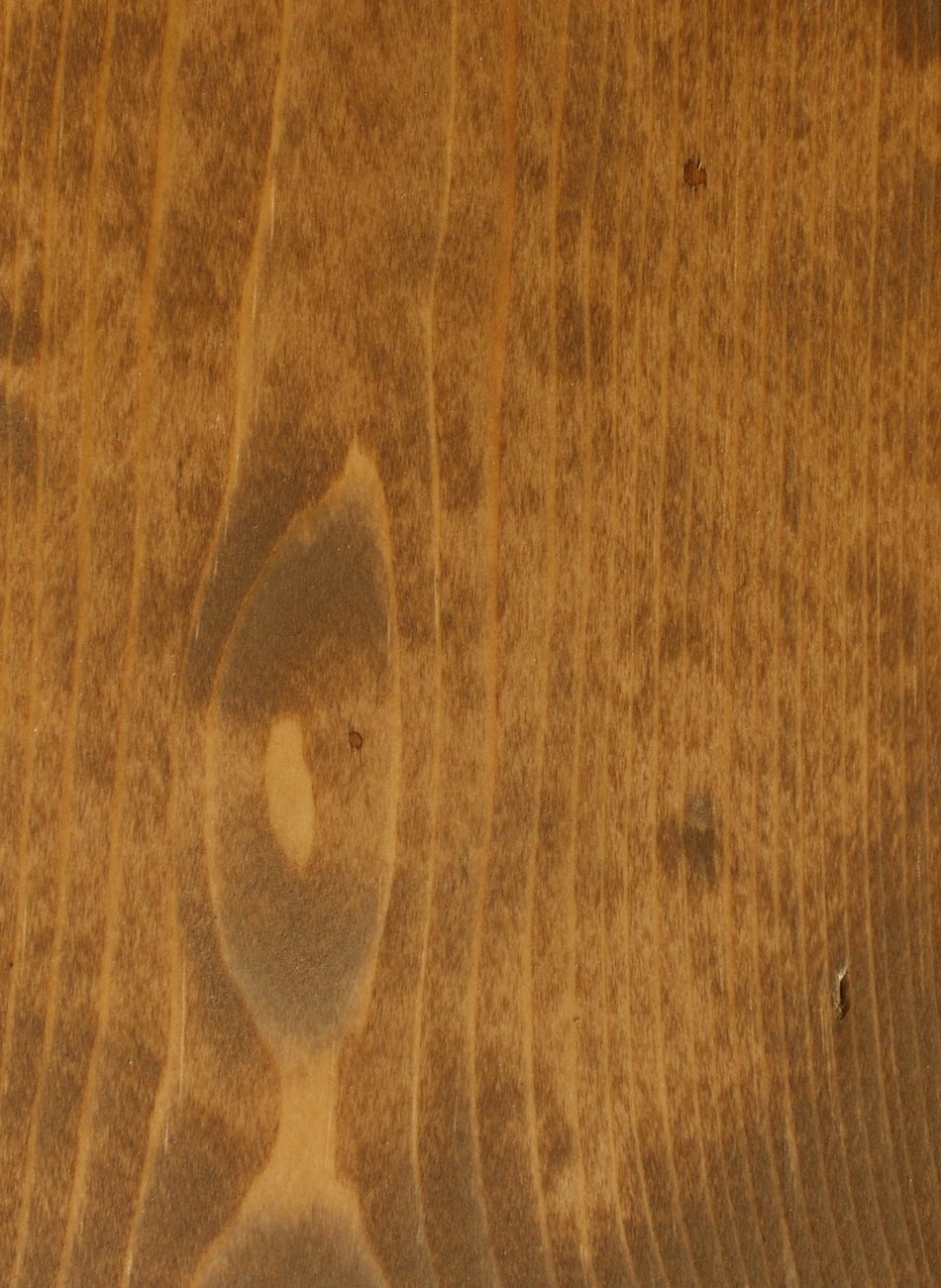
Positive coloring of resinifera
Some coloring solutions contain resins or other additives that give them certain properties. There are stains for highlighting wood pores, for positive staining of resinous woods, for patination effect, for uniformity, etc.
Softwoods are positively colored when the wood pattern is reproduced identically, i.e. the latewood darker and the earlywood lighter. With a normal wood stain, softwoods are negatively colored. The early wood, being more mellow, absorbs more and darkens, while the latewood absorbs less and remains lighter. Positive coloration is achieved by controlling the absorption by adding special resins to the wood.
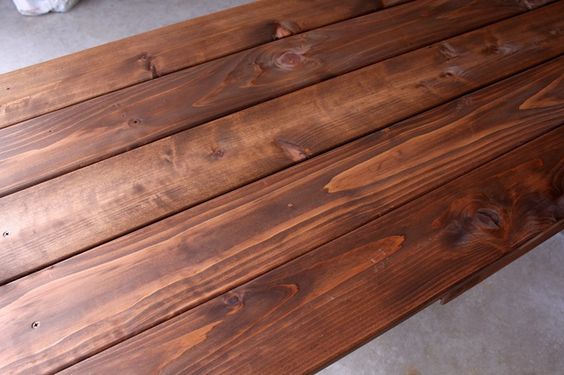
photo source: parlaredilegno.blogspot.com
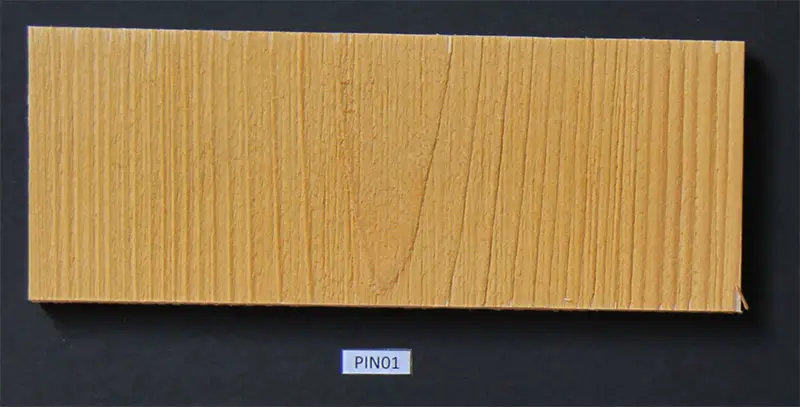
What are glazes
The solutions that give the patina, or ageing, effect are also called glazes. They are sprayed on and then wiped off or applied directly with a cloth. By wiping, the glaze is pushed further into the wood and brings out the design. In addition, it stays in the corners, in areas attacked by blank preparation (holes, chain marks, tearing, etc), in areas where milling has been done, giving that skating effect.
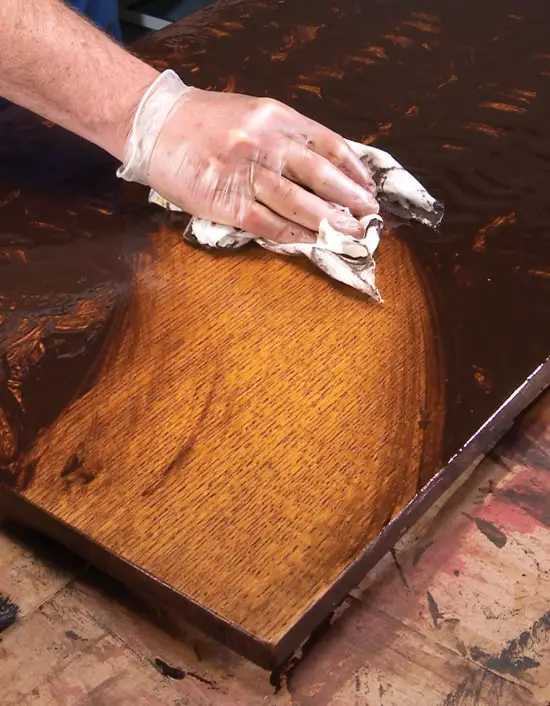
Specific protections for wood used in the outdoor environment
The woods are also differentiated according to their resistance to direct light. In general, interior wood staining is done with ordinary stains without resistance to direct light. If the wooden furniture or objects will be subjected to the action of light in a more intense way (primer and varnish are dried by UV radiation, objects are in a showcase or in a highly glazed space under the action of the sun for a long time, etc.), they should be stained with solutions resistant to direct light.
For outdoor use, in addition to resistance to UV radiation, the solutions must also be resistant to other environmental factors (temperature, humidity, etc.) If the coloring solutions are not formulated for outdoor use, there is a risk of dye destruction, the object gradually fades and the color turns gray.
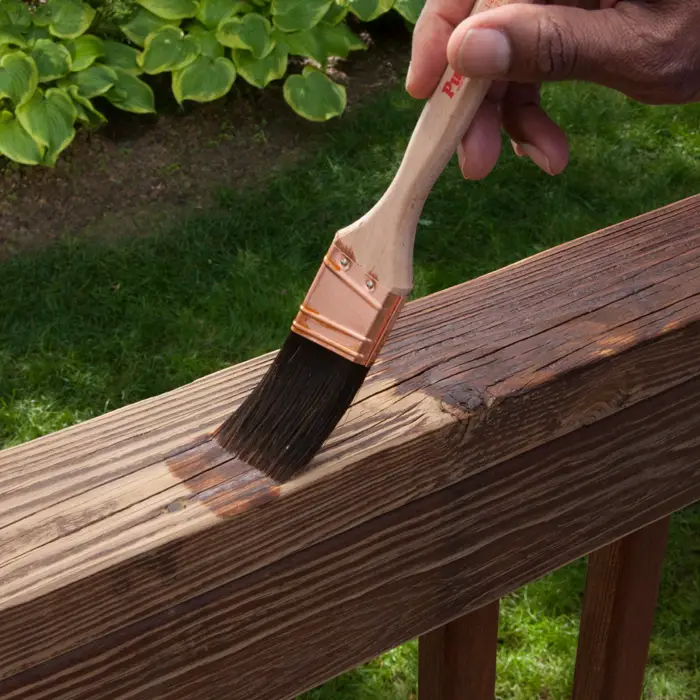
photo source: lowes.com
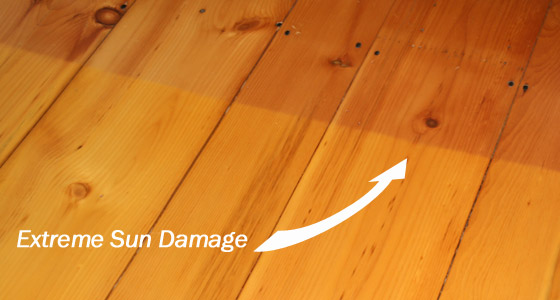
Solvent or water-based dye?
The effect of the baths is also influenced by the solvent. When the solutions are water soluble it all comes down to the influence of environmental factors: temperature, ventilation, humidity. These influence the drying rather than the appearance of the wood after staining.
With organic solvent-based solutions things are different. The colorant is dissolved in a solvent mixture which determines the evaporation time and influences the final appearance of the color. If the solvent is quickly volatile (e.g. acetone) the colorant almost never enters the wood, but remains on the surface. Such a stain is used for leveling, over stain or primer, or for a leveling stain. If, however, the solvent mixture is highly volatile, the stain will penetrate into the wood, stain more intensely and bring out the wood's pattern and pores. Thus, by juggling the solvents, different stains can be obtained with the same colorants.
If the same stain can be dissolved in both water and organic solvents (such as all-purpose stains), then the water-dilutable stain solution will better mark the wood's design and the color will be more vivid. The solvent solution will be more uniform and the color duller. Also, some wood species stain when stained with simple water-soluble stains, but do very well with solvent staining (beech is the best example).
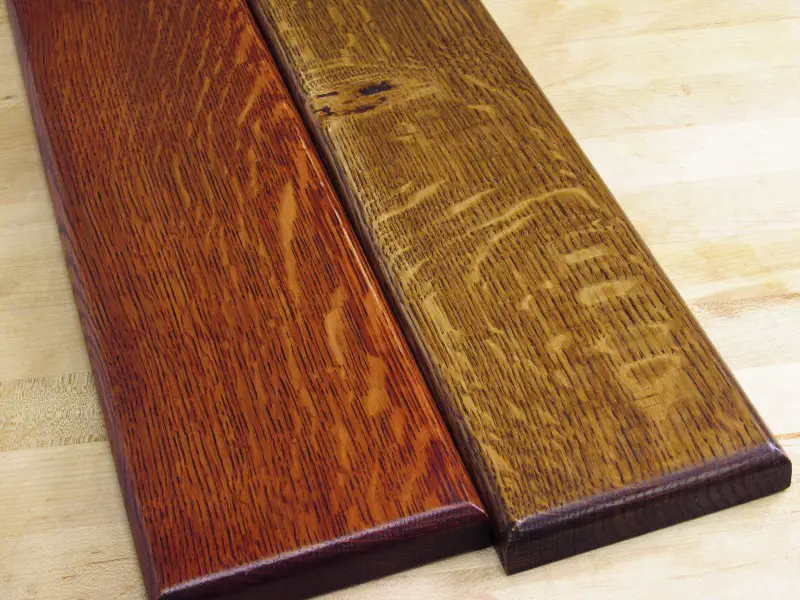
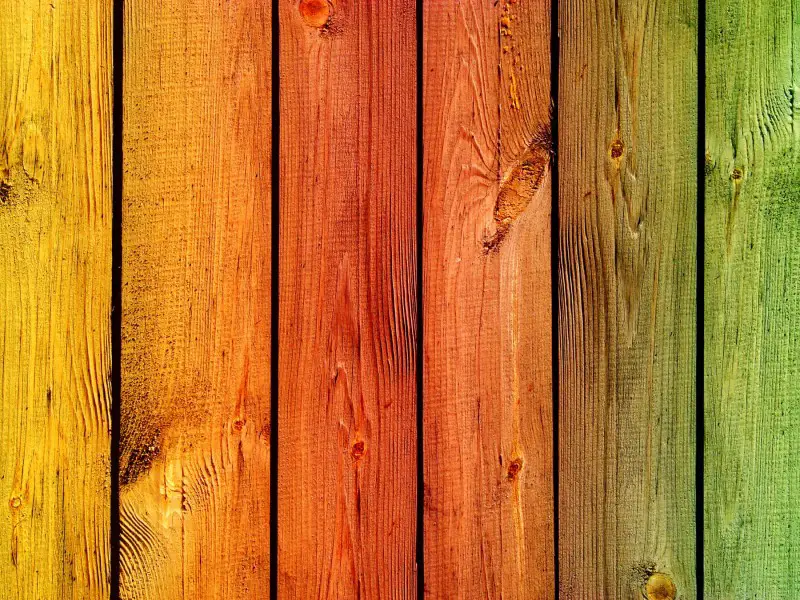
The coloring is also influenced by the method of applying the stain, but that is a topic for another article. In the meantime I look forward to your experiences with wood staining.



































Thank you, Mrs Mihaela Radu! The virtual presence of a specialist in this fascinating field was necessary. Sincere consideration!
Thank you. I write with great pleasure and joy when I see that there are so many of us in this club of wood lovers.
I'm passionate about woodturning and am interested in a way to accentuate the wood design (an effect I usually achieve with an oil), with the possibility of being able to apply a varnish afterwards for finishing.
Thank you!
Hello,
The best way to accentuate the drawing is to erase the baths. The wood must be very well sanded beforehand because by wiping the defects are accentuated (scratches, fibre pulls, mirrors, etc). If you have the possibility to apply it by spraying, apply it in excess, evenly over the entire surface, then wipe it with a cloth. If you use solvent-based thinners, use a slightly slower thinner, but not too slow. There are also special wipe-off baths that contain resins. You can improvise one by putting 10-20% of the primer used as the next coat in the dip. WARNING: the products must be compatible and of the same class (water-water or solvent-solvent). Good luck!
Hello,
Can bait be added to linseed oil (I would like to give the oil a colour)?
And what would you recommend for a dry oak fence, linseed oil or Kober Ecolasure Colorless Wood Impregnator 4L?
Thank you.
Hello,
Linseed oil is coloured with special dyes that are also soluble in linseed oil. You can try colouring the oil using a small amount of alkyd dye. Try a small amount first to see if they are compatible. Put in a small amount and shake well. The oil remains transparent, but it colours a little. You should not exceed 5%.
As far as the exterior finish is concerned, the oil gets into the wood while the varnish (whatever the brand) forms a protective film. If the wood is well dried and absorbs a large amount of oil, it resists very well, even if rain washes it away. You will have to refresh the finish depending on how fast it wears off (it's years).
In principle, varnish should last longer than oil because, as I said, it makes a protective film. However, if it is not very elastic or the wood moves a lot (it is not well dried), the varnish layer may crack. In this case the protection disappears completely, because rainwater will immediately get under the layer of varnish and it will start to peel. Even if this does not happen and the latex needs to be retreated every few years (usually more than for oil). How often you should have the oil re-filled can be found in the manufacturer's instructions.
Dyes for water-based paint? I would like to paint wooden toys, and I would like different shades of the same colours.
Where would I find something like that? Thank you!
Good evening.
You should buy water-based (water-dilutable) stains, available from any paint and varnish supplier or distributor.
All the best.
Good evening Mrs. Mihaela
I have to paint 5 interior doors in ash and some steps in ash..I would like to try to paint them myself..
I bought from dedeman water-based varnish (Oskar oak deskis) what do you think?
Or maybe I apply a dip first and a second coat of clear water-based varnish?
Hello!
From my point of view, the look is more pleasing when you first bathe and then apply clear varnish. The stain brings out the natural wood grain and pores and the varnish gives clarity and depth. In addition, any scratches are less visible on a clear lacquer than on a coloured one.
All the best!
If I can give some advice... I have fitted some interior oak doors (not yet finished). I ordered some oak treads (to match the doors), and found they were made from ash. No more time or money to argue with whoever made them, that's it. But how do I make the steps look like the doors? At this point neither the doors nor the steps are given with anything, it's clean wood. Is there any way I can bring the steps to the shade of the doors (I prefer the oak shade, I know they will darken after varnishing, but I hope they won't change shade, I was thinking of giving them a clear matt varnish). The ash is a little redder (I read that this means the tree was older). Shall I try an oaky shade bath on the steps and then a varnish? I'm afraid of it getting even redder... Thanks in advance.
Hello.
Ash and oak have the same design, they differ only in colour. In general ash is lighter in colour, more yellowish-white, while oak is darker in colour, more grey. I understand from what you say that in this case the ash is redder. In order to have the same colour, you should apply a wood stain to the ash that resembles the natural colour of the oak (that of untreated doors). Don't make the bath very concentrated because there is a danger of staining the ash too dark. Better to apply 2-3 coats until you reach the colour of the oak. Compare the colours only after the ash has dried. After matching the colours you can apply the same varnish on both oak and ash.
Let me give you one more piece of advice. As I said in the beginning, oak and ash wood are very similar in design and structure. A slight difference in colour will not be disturbing. The wood has more shades on one board anyway and that is the beauty of it. I think leaving it as it is initially will break the monotony created by a single colour. In addition, the varnish changes the colour of the wood a little, both oak and ash (To see how it will look wet a small hidden area with water. The wetter it is, the varnished it will look). You may find that varnishing will bring the colours closer together and even eliminate the need to wet the ash.
All the best!
Thank you very much! I wasn't going to put any bath on the doors, as they are gorgeous as they are. Only on the ash steps would I have wanted to, but I was afraid I'd ruin them more. I think I'll take your advice and just varnish them. Anyway I suppose they do change shade over time, maybe in a year they will even out.
Hello. I need some guidance from a specialist.
In the new house we made a wooden ceiling (panelling plus exposed rafters). The style of the house is rustic-modern. The problem is that the builder gave me with bait mahogany the rafters and bait pine the panelling. It looks fff old-fashioned. I don't like it at all.
I'd like to somehow "erase" the dulling and restore everything back to that natural aged wood gray color. I think you know what I mean.
The questions are: 1. what can I use to remove the bath (grinder, sandpaper, granules???) I have to do the work upstairs because I can't take down the ceiling.
2. What can I use for the staining described above that will bring out the wood grain? The wood is resinous.
Thank you very much.
Good evening.
You should sand the surfaces with coarse paper - 80 or 100 grit - to remove the thin layer of wood where the filler has been absorbed. You can do this by hand or with flat or orbital sanders. It won't be very easy because I suspect that varnish has been applied on top of the primer.
After you have removed the colour change the sanding paper for a finer one (150/180/200) and sand the whole surface to make it smooth and ready for finishing.
There are companies that make drinks to order. The grey ones, specific to weathered wood, are not hard to find. But I don't think you'll find them in diy stores. Look for companies that sell professional wood products. You'll also find finishing products there. Say you want wood that looks like naturally aged wood and you're sure to find help.
All the best!
Thank you very much. Now it's all clear to me and I know how to organize myself. I've been looking for grey shades and I thought they didn't exist here.
Hello, I'm from Pitesti and I'm also interested in grey bait and I can't find it, can you tell me something? thanks,
Hello! I would also need an expert opinion. I have a wooden house, covered on the outside with barne wainscoting. It was initially sprayed with lazura. This prevented an even coat from forming due to wind blades. We were not able to do everything with a brush. Over time some areas blackened. Now we have moved on to cleaning (sanding) the surface, except that it is almost impossible to get the "white wood" perfectly clean, mostly because the surface is very large, and with the semi-rounded bars, cleaning is done by hand. I would like to ask you what we can apply next, first of all to "grip" well and protect, but also to mask the color differences between the areas that are accessible for cleaning and those where traces of the previous color remain. Our idea was to apply an exterior primer. Maybe a dip? We have significant exposure to sun on one half of the house and rain on the other. I looked into Sadolin products, only it's applied on a perfectly clean surface. I would also like to ask your opinion about the varnish, because on initial application, the varnished balcony railings have flaked. I would appreciate (I don't know if you have the right) if you could recommend a specific product with a trade name if possible. Thank you!
Hello.
From what you are telling me I understand that the initial coating you applied did not cover the entire surface and in some places it is already gone. Blackening of the wood can occur because the wood has been unprotected and has changed colour or because it has been attacked by fungi and mould. I don't understand if you clean it and it stays black or you fail to clean it at the joints. In the first case it must be treated with insectofungicide products. Special products for wood are available on the market. There are even outdoor wood preservatives that contain insecticides.
But if it's about the areas where you can't reach, you don't have to worry about the adhesion of any product to the support because there is no protection there and that's why the wood has changed colour.
Sadolin products are in the top DIY product range. To stain the wood it is best to first apply an exterior wood stain, then come up with 2 coats of exterior varnish, or a stain varnish in the desired colour to apply in 2-3 coats.
A classic finishing system, commonly used industrially, is bait, primer and varnish. With DIY products it is said to be as easy to use as possible, that's why 2 in 1 and even 3 in 1 formulas are used. Lazura is such a 3 in 1 product. In your case I would not recommend primer because it means a thicker film (which is not necessary in a house) and you would have to sand before applying the final varnish, which seems to be quite difficult. If you still want to use primer, it is applied after the bath and before the final varnish. If you are going to use stain varnish, make sure it is for the outside, as ordinary varnish will fade very quickly in the sun. The final varnish should not be completely transparent. Pigments are the ones that protect against UV radiation and a totally transparent and glossy varnish lacks protection.
As for the railing, you will have to sand the remnants and apply another coat of varnish. It's very hard to find a product that will adhere to the varnish residue (not only Sadolin). It is good to clean the railing thoroughly and then apply the new varnish. Don't apply a thick coat because it will crack more easily. You can try the filmless finishes (oils). They don't make a film, so there is no risk of it flaking off. Only, depending on how weathered it is, the finish needs to be re-sprayed every 2-3 years (without sanding). Linseed oil is resistant on the outside.
I hope I've been useful.
All the best!
You can also find a lot of useful information in the printed Wood Magazine. This year there are 2 issues, in March and September. Subscription details can be found here: https://revistadinlemn.ro/product/abonament-revista-din-lemn/
Hello!
Thank you for your prompt and very detailed response! Indeed, you have given me many answers to my questions. The wood changed color in places where it was less protected. In the meantime we have started manual cleaning (which seems to be very difficult and time consuming, it is about 400-500 m2 of floor space plus balconies) by sanding with abrasive sponges. It seems to be a difficult task to do to very good standards. Do you recommend sandblasting? Can it be applied on resin wood bars? For further finishing, the idea of linseed oil seems the most interesting to me, but I would like to know if only oil is applied, in how many layers it would be recommended and if pigmentation with another product can be added. Can only the oil remain in the final coat? Thank you!
Good evening.
Blast cleaning is a very good idea. But it's good to call someone who does this routinely because it means some mess and danger. Find here more information about blasting.
Oil is harder to colour. You should use mineral pigments, mix a small amount of oil with the pigment until it becomes a paste and then dilute with the rest of the oil. Easier is to colour beforehand with outdoor bait (water or solvent based), salt it to dry, then apply the oil.
Linseed oil can remain as a top coat. You should apply 2-3 coats, so that the wood absorbs as much as possible inside. But it is not good to apply too much (the surface should remain oily) because the wood becomes sticky over time.
Good luck!
Thank you very much! Your detailed answers are very helpful! Good luck in the future!
hello, if and how to change a dark shade to a lighter shade on a wooden structure painted with 2in1 mahogany and I want a lighter shade - teak, please reply by email ursu.gelu@gmail.comwith thanks
Good evening
I also want some advice from you.I want you to tell me what to use (brand,type,etc) to "color"""
1..10mm veneer boards in depth.I use these boards as separators between thicker natural wood boards (segmented bowl),and the whole will be turned,sanded,etc.In the old days I used to get a professional bath from furniture factories.Thanks in advance! dn_scurtu@yahoo.com
Hello!
It's harder to find bath powder now, even at factories. It has been replaced by colour concentrates in liquid form. They can be diluted with water or thinner to the desired intensity. There are also universal concentrates that can be diluted with both water and acetone or alcohol. For deep colouring the best ones are those diluted with water. The solvent evaporates quickly and the colour stays longer on the surface.
You can use such concentrated wood finishes from any distributor of professional wood finishing products (ICA, Milesi, Renner, Sayerlack, Sirca, Sherwin-Williams). Some of them also sell online.
All the best!
Hello!
Congratulations on all the varied and pertinent information about this extraordinary material, wood.
I am interested in the solution applicable to protect a coffered ceiling with pine panelling in the bathroom.
Thank you.
Hello!
Thanks for your appreciation.
Being in the bathroom where there is a lot of steam and humidity the wood must be very well protected. In my opinion the best option is oil (linseed oil, Danish oil, tung oil). Give several coats with a 24 hour break between them for drying so that the wood is as impregnated as possible. Do not leave any unprotected areas because the wood will absorb, swell and may mould. You can also give 4-5 coats because our resinous wood is looser and absorbs more. Wipe off the excess because over time it becomes sticky. If you decide to use linseed oil, use boiled oil or spice oil. In the link below you have more information about linseed oil. You can also use oil-based paints (alkyd paints). The oil in the composition protects well.
You can also protect with varnish, but you must use one resistant to hot steam and humidity (polyurethane). I think you'd be overcomplicating for a bathroom ceiling, but it's your choice.
All the best!
https://revistadinlemn.ro/2018/05/15/ulei-de-in-cand-unde-si-cum-se-foloseste-cum-sa-ti-faci-singur-vopsele-de-ulei/
Don't forget to subscribe to the printed Wood Magazine! For only 58 lei/year you can find out news in the field, discover craft ideas or trade secrets. We remind you that the content in the printed magazine is different from the one on the website. Details in the link below.
Thank you!https://revistadinlemn.ro/product/abonament-revista-din-lemn/
The beautifully finished beech that will be used for the floors inside, what can it be stained with to look nice? Thank you
Good evening.
The beech is very tricky to colour. It stains easily. Mostly stained with water-based or tar-based stains (with white spirit). Use solvent-based stains. It would be best if you could find special beech wood stains.
You can use coloured varnish. In this case the absorption in the wood is less and the wood does not stain.
All the best!
Good evening,
I want to change the colour of the furniture in my bedroom and need some information. The desk is oak veneered, I like the color, I just want to improve its look because it is worn out. The rest of the furniture is laminated beech (I don't know if that's the right term) in two colors: light brown and dark blue. Can the blue part be painted? Otherwise I don't see how I could get rid of it. For the brown part I would like to highlight the wood, maybe make it a bit darker, this light shade I don't like or maybe it doesn't fit in combination with blue. And what are the steps and products used for this.
Thank you!
Hello.
The veneered oak desk should first be cleaned, i.e. washed with water and detergent and then thoroughly wiped with a dry cloth and left to shake. Do not use plenty of water but a damp cloth. Too much water can loosen the veneer. Buy clear wood wax and apply a layer of wax and polish it. The wax will brighten the finish and the desk will look much better. In the link below you also have a natural maintenance option.
If you are not satisfied with the wax you can buy a transparent water-based varnish, glossy or matt depending on how you want it. Apply a coat of varnish over the existing but cleaned finish with a brush and let it dry. If you think you still need it, apply another coat.
I think the material you are talking about on the rest of the furniture is beech-look chipboard. In this case you can only paint with products that adhere to such surfaces (such as Annie Sloan paints). You can paint the blue part, but you will see the difference very well because they will be different materials. You can paint both sides using whatever colours you like. If I am not clear about the material, please let me know and I will tell you how it can be finished once I have identified the material.
All the best!
https://revistadinlemn.ro/2018/07/19/variante-naturale-de-curatare-si-intretinere-a-mobilierului-si-pardoselilor-din-lemn/
Hello!
We have a house under construction where we have done the roof but have not managed to install the roofing. Basically the roof was just left with last year's anti-condensation film from December. Our plan was to fit a grey anthracite coloured cladding and to give the panelling that is showing a yellowish pine type bait to make a nice contrast. The problem is that in the meantime it has rained a lot and when we went by the house we noticed that absolutely all the panelling had black spots. Is there anything else that can be done to restore the pine colour to the panelling without the black stains showing? Is there any treatment that needs to be done beforehand to avoid mould problems?
Hello.
The black spots are mold. You can try removing it with a solution of sodium hypochlorite-based laundry bleach (the cheap kind). Wipe the surface first to remove any black mould that is not embedded in the wood. Apply the hypochlorite solution to the wood, let it work and apply again after 1-2 hours. Leave until the next day and see if the blackness has disappeared. If it is not completely gone, sand the wood with 120-150 grit sandpaper, remove the dust and reapply the solution. It should disappear.
Before painting in pine colour you should treat all the wood with an insect-fungicide solution. You can find such solutions in DIY or specialist shops. Clearly there is a danger of mould reappearing.
After the protection solution has dried you can apply the pine colour dip.
All the best!
Hello,
I want to finish a wooden lamp, and the finish I'm after is similar to https://redposie.com/blog/wp-content/uploads/2014/10/IMG_8752.gif
The wood is soft, and at the moment I'm thinking of using a white varnish, then a shade of blue and then dark varnish.
I just have some concerns.
1.From what I have read, there is a possibility that the paint may be spotty, and priming is recommended. If the first coat is primer, when they come with the bait after, it won't adhere to the wood and the design will lose contrast, right?
2.I can't really find any colour bath, and I was wondering if I could get a colourless one and mix it with pigment? or maybe you can recommend a manufacturer/store.
thank you
Hello.
The patina (the blue layer) is used to achieve this effect.
1. If the wood is soft there is indeed a possibility of staining. Primer is a solution, but only applied very thinly. Basically, the primer you apply should be diluted 1:1 with its solvent (water or organic solvent, depending on what kind of primer you use) and applied in small amounts so that it absorbs into the wood without deforming the film. It will work as a barrier and the filler will settle evenly (it will be absorbed evenly).
2. As I said, the effect is achieved with the oxidized copper patina (it is a slightly bluish green). You can find such products at wood product stores, those that also sell varnishes and paints. They generally sell professional products, those made especially for factories, and they also have such patinas.
If you apply a blue bait over the white bait the effect will be different. You can apply white bait, over it a layer of clear primer for protection, and over this primer a thin layer of blue paint. After drying, sand partially to remove the blue colour only in some places where the white will appear. The method is called distressed and you have a link below where it is described in detail. If you don't apply primer the paint takes much harder.
With bait and patina you will get the effect and the wood will show through.
Good luck!
https://revistadinlemn.ro/2016/09/06/distress-metoda-invechire-mobilei/
hello. what do you suggest me to get a havana oak color.
Hello.
I don't understand exactly what you mean. If you want to stain your wood a havana colour you need to find a wood products distributor who can make you such a colour. I don't know if the colour can be found ready made in DIY stores.
All the best!
Hello.
Call a company that sells professional wood varnishes and paints. Many of them prepare baths on request.
If you want to do it yourself you should buy black, red and yellow liquid bait and try it out until you get the colour you want.
All the best!
Good evening.
This year, after many years, we started to do some renovations to our parents' house. About 40 years ago, the area flooded and the walls were leaking. And when we were little the hallway walls kept crumbling. Until they decided to put up solid pine paneling. Now they've knocked down some of the walls and we've had to continue with the panelling. Only on one of the walls we had to continue with new panelling. The old panelling was stained with a water based stain and then varnished. Now we sanded it. We gave it a decay treatment and Sadolin primer. Only I would like to get a somewhat uniform colour. After repeating the decay treatment and another coat of primer, what type of varnish should I use??? Thank you!
Hello.
To get the same colour you should have first applied the desired colour of the wood to the entire surface, both old and new wood. Afterwards apply the wood stain treatment and primer.
Now you can try to even it out by using a clear, coloured varnish, also from Sadolin. First apply a thin coat to the lighter area, then apply another coat over the entire surface.
Good luck!
Hello! I have to paint the house stencil and I chose to apply thinner based paint, but I have a confusion! What type of paint is more resistant: the glossy one or the super glossy one? Thank you!
Hello.
Paints resist to the outside even if they are glossy or super glossy. Lacquer is the one that doesn't, because it has no pigments or matting agents to get in the way of UV rays. The difference in resistance between glossy and superglossy lacquer is not too great. The noticeable difference is between gloss and matt varnish.
All the best!
Don't forget to subscribe to the printed Wood Magazine! For only 58 lei/year you can find out news in the field, discover craft ideas or trade secrets. We remind you that the content in the printed magazine is different from the one on the website. Details in the link below.
Thank you!https://revistadinlemn.ro/product/abonament-revista-din-lemn/
Hello, I also need some advice for my first wood painting project. The furniture in the kitchen was - part bought, part custom made. MDF material, with similar cutouts. The problem is that part of it is Arin shade and the other, with a reddish tinge, Cires (because the original shade is no longer produced). What solution can I find to get a uniform colour, but not very dark? What should I choose - water soluble paint or bath? I would prefer to keep that specific wood pattern. Or at least avoid a cheap/ugly final look. Or would it be safer to paint the whole piece of furniture in a white-vanilla colour? Thanks in advance
Hello.
I'm sorry, but I don't understand what kind of furniture you have - wood, painted MDF, finished veneered MDF or moulded MDF (with foil with printed wood design). The finishes are different, and to make them uniform the only option is paint. The wood stain is only used directly on the wood (if the new bodies are made of wood). If the MDF is moulded (with foil imitating the design of the wood) not all paint adheres to the substrate. You can try with chalky paints.
If you can help me understand what this is all about, I would be happy to direct you.
All the best!
good day
thank you for your attention
the material in question is finished veneered mdf, for both new and old furniture
I look forward to your advice and recommendations
Hello.
You have 2 options. One would be to varnish the furniture with a cherry coloured varnish (in the shade of one of the bodies). Apply 1-2 coats on both bodies. You will get a uniform colour and the natural wood pattern will still be visible. The disadvantage is that it will have a slightly plastic look. To have the wood nicely coloured you should have first wetted the wood and then applied the clear lacquer. In your case the furniture is already finished and you should remove the finish down to the wood, bathe and then apply the clear lacquer. To lessen the plastic effect choose a matt varnish.
The second option is to paint both bodies in the desired colour (white-vanilla). You won't see the natural colour, but I think it will look better that way. You can use creamy paints (Annie Sloan may be a solution). Before applying the paint wash the bodies well with water and detergent to degrease them. Otherwise the paint will not adhere to the surface. Apply 2 coats, with drying in between. If you want a smooth surface with a pleasant feel you should sand between coats. Chalky paints should be sealed at the end with wax to avoid absorbing moisture.
You can also try with alkyd paints (similar to oil paints), but you have to check the compatibility between coats first. If it has been solvent based varnish before, when coated with alkyd paint the top layer "cracks", it looks like a glass surface with many cracks. Try before on a less visible corner.
Good luck!
Good evening, I need some advice, I have an old barrel that I have polished and I would like to give it a brandy notation, what should I use thank you
Hello.
The closest to the cognac colour is the chestnut bath. You can also use reddish walnut coloured bait, which you can dilute with 30-40%. Then finish with linseed oil.
All the best
Good evening, I ordered a 3.60 m natural wood curtain gallery and somewhere in the middle there is a brownish stripe .I spoke to the company and they told me that the wood was soaked .what can I cover that stripe with considering that it is varnished .I am afraid to take it down to send it back and I was thinking maybe you can give me a solution .
Good evening!
There's not much you can do. The gallery being very long was probably painted in pieces. That is the area where the areas met and the operator overlaid the colour (he went over the area that had already absorbed the dye). There is no way to fix this at home.
In a factory or workshop a uniform solution could be applied to darken the lighter areas. This is the simple option that will result in a gallery with a darker colour than what you originally wanted. The solution to get what you ordered is to sand the gallery down to the wood and refinish.
All the best!
Don't forget to subscribe to the printed Wood Magazine! For only 58 lei/year you can find out news in the field, discover craft ideas or trade secrets. We remind you that the content in the printed magazine is different from the one on the website. Details in the link below.
Thank you!
https://revistadinlemn.ro/product/abonament-revista-din-lemn/
Hi Mihaela,
I congratulate you on the article,
If I may, I have a question.
We custom made some doors + side lights + top lights from pine. The problem is I don't like any of the baths recommended by the carpenter. All of them show pine fibre. So where there is fiber, it's lighter than the rest. I'd like everything to be uniform, a walnut like color.
Can it be done as I wish? Can you give me some advice?
Thanks in advance,
Sincerely,
Ionel
Hello!
Thanks for your appreciation.
The appearance you are talking about is called negative staining and is specific to softwoods (fir, spruce, pine, larch). Late wood, which is harder and darker, absorbs less or almost no stain. Early wood, whitish and bluish, absorbs more and darkens in colour. In the end the appearance is like the negative of a photograph.
To avoid this, special resinous wood staining baths can be used. Companies that distribute professional wood finishing products have such baths.
As everything is based on absorption, a little artifice can be made. Initially apply a layer of transparent primer diluted so as not to make a film but only to block absorption in depth, then apply the dip. The appearance will be more uniform and the colour will catch on the wood side later. It is important that the two products - primer and filler - are compatible and that the filler can be applied over the primer.
All the best!
Eiii... exactly this kind of professional response is often lacking in our country. Congratulations on the article.
Thank you!
Hi,
I started building an indoor staircase out of fir wood. The steps are made of 45 mm thick pine elements with a width of 270 mm and a length of 900 mm.
When I have time I am looking for information on finishing these steps. However I have not come to a final conclusion, as opinions are very diverse.
I'm still leaning towards a coloured oil finish, even if I have to resurface once a year.
What do you advise me to choose for finishing: oil, varnish, bait, polyurethane varnish, paint, etc.
I should mention that I would like the finish to have a hint of walnut brown, I mean I don't like pinkish-yellow wood.
Thank you
Hello!
I would choose the oil because it gives the wood a nice natural look. And if you are willing to refinish periodically, then you really have nothing to fear. It is good to do the wood staining before oiling. That way the colour won't fade and it will be sufficient to re-apply the oil protection from time to time. You can use any type of bait - solvent based or water based - the important thing is that it is completely dry before applying the oil. Over the oil you can apply wax. This will give a better resistance over time. Use ordinary floor wax, which you apply with a rag and polish the day after application. You will get a very nice silky look.
That's what I would do, because I like materials that give wood a natural look. But I should mention that the best resistance to scratches and mechanical shocks is achieved with polyurethane floor varnish.
All the best!
Hello
Hello,
I'm in the process of building a wooden fence (45 m2) with planed pine timber. I would like a protective solution for a longer period (3-5 years), and with the possibility of quick/easy repair. Is it sufficient if I apply 2 coats of "3 in 1 wood stain, Kober Ecolasure Extra, light oak, water based, indoor/outdoor, 10 L"? or should other solutions be applied before/after?
What do you recommend?
Thank you!
Ovidiu
Hello!
The 3 in 1 coatings must contain a quantity of pigment that protects against solar radiation, insect-fungicidal substances and film-forming material for protection against humidity. Having all this, nothing else is needed and the varnish can be applied in 2-3 coats to protect the fence. 3-5 years, as desired, is an average guarantee in the market, so the product should last. It is best to check with the seller the warranty given by the manufacturer.
My recommendation is not to give the layer very thick and better to give 2-3 thin layers than one very thick one. The resistance of a finish consisting of several thin coats is much better than that of a single thick coat. In addition a thinner coat is better absorbed into the wood and provides better protection.
I admit I am a fan of oils, but they don't give you that long without proper maintenance. It's easier to refinish though. A film finish, when it starts to peel, needs to be removed entirely before applying another coat, even if the products are the same. In oil, however, the coat does not have to be removed, but the re-spraying of the finish should be done at most once every 2 years (if rainy years and sooner).
More about finishing fences can be found in the link below.
All the best!
https://revistadinlemn.ro/2018/03/09/garduri-din-lemn-cum-se-alege-lemnul-materiale-de-protectie-sfaturi/
Thank you very much for your answer. Very detailed and accurate. In the meantime the Kober people recommended me to apply a coat of impregnator before varnishing for up to 8 years protection. Seems a bit excessive to me 8 years ... but who knows.
All the best!
An article full of useful information! Thank you!
Hello,
I have a natural larch wood floor installed 20 years ago.
The problem is that I started redecorating and it doesn't match my natural color. I would like to know if it can be changed to a more grey or lighter colour - to a beige, given that the larch has a bit of red in it.
If the colour can be changed, how should I proceed?
Hello!
To change the colour you need to get to the wood by removing the current varnish or paint, completely covering the wood. Otherwise it's hard to get rid of that hint of red, even if you apply a coloured varnish over the existing one.
The first option would be to scrape the pole, stain it with a grey varnish, then protect it by applying 2 coats of floor varnish.
If you prefer the paint option, wash and sand the surface lightly, then apply a gray, semi-transparent or opaque paint. In the first case (semitransparent), the paint will partially cover the surface, giving it the appearance of a straveziu wave. In the second case, the paint will cover completely (the wood will not be visible at all). If the existing varnish layer is not very thick, it is possible that the paint will "copy" the natural design of the wood, which will become visible (like a fingerprint), without the wood actually being visible.
All the best!
Hello
I bought a house and I have light grey stained beech steps and the rest of the floor is ash stained oak brown.
How do I go about getting them to the same colour (my preference would be to just finish the steps).
Hello!
There are 2 solutions. You can use a dark walnut stain to coat the steps or strip everything down to the wood and refinish.
The first solution is simpler, but in the end you get a look closer to plastic. The varnish will act as a coloured barrier and you will lose the charm of the wood.
With the second solution you have more work to do but the result will be much better (from my point of view). To remove the existing finish on the steps you will have to sand the wood until white or use a pickling solution (e.g. Decanol). After removing the soaked varnish coat and wiping the surface with thinner, let the wood dry thoroughly and apply a coat of bait in the desired colour (dark walnut). Let it dry and apply clear varnish, 2 coats with sanding in between to get a smooth surface, pleasant to the touch. Sand between coats after the varnish has dried completely. Use sandpaper with a minimum grain size of 280 or fine sanding sponges.
Good luck!
Hi. I bought a solid oak floor from dedeman 2 years ago, but only this week I installed it. Probably due to drying, some boards showed differences of 1-2 mm, so I thought I would grout it here and there, then sand it on the grout. I got some spots from this matting. How can I even out the colour? I'd like to point out that the shade is Antique Patina.
Hello.
If you've made it all the way to the flush you'll need to find a similar bath and do the repair locally, with great care. It is a more difficult operation and it is better to call a specialist.
But I think it's just about sweeping the floor. In this case that portion should be polished. You can do it with a piece of tile. If you don't see any improvement, put a few drops of car polish (2000 or 3000 grit) on the piece of polish, polish until you get the desired shine, then wipe with a clean piece of polish. The operation can also be done with a rotary polishing machine on which you apply discs of polishing paste. For protection you can apply a thin layer of wax at the end.
All the best!
Hello!!!
I have a question for you if you can help me with some advice
I have a very old solid beech wood floor and now I would like to stain it black or grey
How can I achieve the desired colour?
Thank you!
Hello!!!
I have a question for you if you can help me with some advice
I have a very old solid beech wood floor and now I would like to stain it black or grey
How can I achieve the desired colour?
Thank you!
Hello!
There are 2 options, with bait or with paint. In the first case you have to scrape the floor to get to the wood. Then you stain the wood with solvent-based bait, not water-based. Beech is stained with water-based stain. Use black or a mixture of black and white wood stain for grey. You will get a grey with bluish tints. Allow to dry and apply 2-3 coats of floor varnish, sanding after the first coat has dried. You will get a surface where the natural structure and pattern of the wood is visible.
For the second option, simply wash the surface of the parquet with water and detergent, wipe well and let it shine. Then gently buff with a fine abrasive sponge to give the paint a good adhesion. Dust and apply 2 coats of black or gray paint. You will get an even surface, but the wood will be "hidden" by the paint, its natural design will no longer be visible. As we are talking about beech, if it is not cut with a flader (cathedral cut), the difference is not very big because beech is a rather monotonous wood.
All the best!
Hello. I bought a walnut-coloured chipboard cabinet. Is there any way to change this color to a dark brown shade?
Hello!
I'm guessing it's the chipboard, meaning the one with the printed wood design. The only solution is to paint it. But the adhesion is quite low and you should sand the surface slightly before applying the paint. There is also the option of the Annie Sloan creamy paints, which do not require sanding. Such paints must be protected with wax at the end.
All the best!
https://revistadinlemn.ro/2017/07/25/cum-poti-transforma-simplu-vechile-piese-de-mobilier/
https://revistadinlemn.ro/2018/01/23/vopsele-cretoase-annie-sloan-chalk-paint/
Hello!!! Please tell me how can I change the color of a wooden furniture? Can I paint directly with another paint over the varnish?
Good evening!
You can paint directly on the varnish. But first you must degrease the surface and sand it lightly, just superficially. Degreasing is done by washing with water and dishwashing detergent or ordinary soap. After washing, wipe thoroughly and allow to dry. Before applying the paint, sand the entire surface lightly with a fine abrasive sponge or 280 or 320-grit sandpaper. Dust and apply the paint. Use water-based paint as it is compatible with most types of varnishes and paints. Try it on a hidden corner first to see if the materials are compatible. If they don't "match" you can see it immediately - the paint you apply will slide on the old varnish layer and form craters or islands. If they are compatible, apply 2-3 coats, with a brush, for the best coverage.
All the best!
Hello! I would like to make a holster to give it a wenge color and protect it with a specific oil (I noticed that Tung Oil would be the best option). Please tell me, what paint or varnish do you recommend, considering we are talking about a surface that will come in contact with food?
Good evening!
Use water-based food colouring or natural pigments for colouring the stew. Allow to dry and then apply pure mineral oil. This is the material usually used to protect objects that come into contact with food. You can find it in pharmacies.
In the link below you can find more information about the materials used for the finishing of wooden hinges and wooden kitchenware.
All the best!
https://revistadinlemn.ro/2019/07/11/protejarea-vaselor-de-lemn-din-bucatarie-cu-materiale-netoxice/
Hello. For UV protection of a new fence, which linseed oil-based lacquers are suitable? Thank you.
Hello!
The coloured ones have UV protection. The colourless linseed oil only protects against moisture.
Outdoor coloured lacquers with oil mixtures are the most resistant. Kreidezeit coloured lacquers are a good choice.
All the best!
Good evening. I'm glad I found this site with many pertinent ideas. I would be glad if you could help me with some advice. I want to repaint some old kitchen furniture (it was painted a long time ago, I think with some oil paint...) I would prefer to apply the new paint over the old one. I read the advice you gave to a lady who wanted to repaint the doors. I find them very useful. My question is: what paint would be the most suitable for repainting an old piece of furniture (pine). It is red now and will be painted white. Thanks!
Hello!
It is safest to use all oil paint or alkyd paint. You can find them in any DIY store. They are compatible and you won't have any problems.
Before repainting, wash the furniture thoroughly with soap and water or dishwashing detergent to degrease it. Don't worry, nothing bad will happen. Wipe thoroughly and leave to rust. Then apply the new paint. Apply min 2 coats, drying between coats. For a flawless surface that is pleasant to the touch, sand the first coat, after drying completely, with a fine abrasive sponge (also available in DIY stores).
All the best!
Hello. I would like to know how I can achieve a similar colour for oak and beech. It is a staircase that has the last steps in beech. Thanks
Hello!
The information you give me is too little to give you concrete advice. I should have known if the steps are varnished or not, if you have only a few beech steps and want to bring them to the color of the oak ones, if they are new or old, etc.
An oak colour is hard to achieve at home if you don't have experience. The easiest way is to buy such a wood stain commercially. You can find them at DIY stores or specialist shops selling wood preservatives. They can be solvent-based or water-based. Although the water-based ones are easier to work with, I recommend the solvent-based ones. Beech is a more difficult wood to stain and stains easily when using water-based wood stains. To avoid staining you can put a small amount of stain in the varnish, so that the varnish continues to be transparent, but still reaches the colour of oak. Cover the beech steps with this varnish.
In general, the oak colour is obtained from yellow and brown or from yellow, red and black, in different proportions depending on the shade of the oak (dark, light, antique, etc).
All the best!
I have a country house with walnut colored double glazed windows surrounded by a border of panelling and a house clad with panelling.The house consists of 2 floors, the first of plastered wall (but I have not yet given any color) and the second floor of wood clad with panelling.I painted the panelling with oskar varnish in chestnut colour and now I don't know what to use on the window frame to make the window frame and the chestnut panelling look good.Maybe you can help me with some information on how to arrange the colours to look good on the outside.Thank you for your time.Health and happiness with your loved ones.Sincerely Florin.
Truly He is risen!
In my opinion there are two possibilities: stay in the same colour area or use a strong, contrasting colour that makes the windows stand out. In the first case I would use a lighter or darker shade of chestnut or walnut. That way you would stay in the same register, but without losing the colour in the window or panelling. You can also use a colour that is a mixture of the two (part chestnut and part walnut).
In the second case I would use strong colours, yellow or green. These are colours that go with chestnut and walnut and would be a splash of colour around the windows that would personalise the house.
Good luck!
Hello, I am planning to make a desk with a spruce top and I would like to give it a darker berry, possibly towards walnut.
I would need guidance, what bath to use, what coating to use, and possibly more concrete where I can get it from.
Thank you
Hello!
Being a small quantity I advise you to buy the products in DIY stores (MAM Bricolaj, Dedeman, Hornbach, Brico Depot, Leroy Merlin). They are products made especially for easy use, for projects that you do yourself at home. Smaller quantities of materials are also available from distributors of wood finishing materials (Sirca, Ica-Lomilux, Renner-KronColor, Sayerlack, Milesi, Sikkens). At such shops you will also find people to help you with instructions for use.
For staining you can use walnut, red walnut, antique walnut, chestnut - if you want a lighter shade or venge for a darker one. Sand the wood well beforehand (180 or 220 grit or medium abrasive sponge) for an even, stain-free stain. Apply with a brush or trowel and immediately wipe off excess (if any). After drying, use oil, wax or a water-based varnish.
All the best!
Hello!
I have a half-timbered cottage outside. The builder has applied a SPOR 3 in1 varnish in the colour Rosewood. On the cap it was a lighter color for the first coat and dark for the second coat. Sprayed on the first coat and it came out a dark color as specified on the box for two coats. The colour is too dark and I don't like it. How can I change the colour? I want a lighter color that highlights the details of the construction better. Thank you.
Hello!
Probably too thick a coat was applied, the recommended grammage per coat was not respected.
Unfortunately there are not many options to change the colour. Either apply 1-2 coats of rosewood varnish mixed 1:1 with a similar colourless varnish, or remove the applied coat and re-finish. In the first case you will get an overall lighter coloured look, but you will lose the natural pattern of the wood and it is possible that the finish will look like veneer. In my opinion you should remove the applied layer (sanding or stripping) and resume finishing.
All the best!
Dear Madam,
I need your help too. We have ordered some beech wood for an interior staircase. We have applied a dark oak wood filler and will varnish it for strength. Unfortunately, after we applied that filler, all the imperfections of the wood are showing, stains. I don't know what to do to save the situation. I can send you some pictures if you can. Please kindly help us with some advice so we can straighten things out. We have spent enough money on material, on carpenters for cutting and fitting, on caulking and varnish and we can't afford to do another one. Please! Thank you very much!
Hello!
Unfortunately, that's what bathing always does, it brings out all the imperfections in the machining.
You have 3 options:
- sanding down to the wood (total colour removal), sanding the wood, on the whole surface and along the grain, with 180 or 220 grit sandpaper, sanding and staining with solvent based bath (water based bath may stain the beech). This is the option I recommend.
- application of transparent coloured varnish so as to obtain a uniform colouring. The coloured varnish can be obtained by putting up to 10% bath in the varnish. ATTENTION! If the varnish is solvent based add solvent based bath, if the varnish is water based use water based bath. Depending on how stained it is you may need 2-3 coats. The disadvantage of this method is that the wood can become plastic looking. You may also not get the desired uniformity.
- painting with a thin layer of paint in the desired colour. After the paint has dried, the floor varnish is applied. The thin layer of paint will show the natural texture and pattern of the wood and you will get an even surface. You will, however, lose the wood grain.
All the best!
Hello, Dear Mrs. Mihaela, how glad I am that someone with expertise and passion responds patiently and competently to every "novice" . I don't know how they do it but how I do it I can't find anyone to do, in this forum. I'm interested in the practical process of repainting.
I also have 2 questions about a house in the country that I am repairing/restoring. The house is from 1890.
1. The bridge is enclosed with pine wood. According to the local tradition, these Banat wood planks were treated with black burnt oil. The last time was about 40 years ago. You can still see a little blackness on them. What should I use on these planks to either keep the black colour or give them a new brown colour? In the latter case the paint should stick to the pine wood. What kind of paint should I use and how should I prepare the painting surface?
2 Last year I cleaned the peeled paint to the wood on the rollers, I gave with a universal primer (white color) but that did not get into the wood, like that yellowish primer from the 70's in the wood and then with Trinat enamel glossy flexible hydrophobic, paint for interior/exterior 2 coats.
It's been practically 2 summers and I've seen it start to peel with primer and all, in places. What did I do wrong? I don't want the same thing to happen to the rollers in town that I intend to paint as well. Here the paint I'm going to apply over the old one, which is still pretty good, and it's with linseed oil. ( I had reservations 20-25 years ago.) Thank you so much for your reply. Have a nice day and good health.
Hello!
Congratulations on the idea of saving such an old house!
1. If no oil has been applied in these 40 years, you can use any kind of finishing materials. If there are black areas, I'm inclined to think there is dirt or mould. You should clean the surface with a wire brush, then sand the surface with 150 or 180 grit sandpaper. Then you can apply an oil-based varnish in the desired colour, acrylic paint or oil-based paint. The coloured varnish is transparent, leaving the wood design visible. The paints are opaque, covering the wood completely.
If the wood is not outside, I would go for the option of staining the wood with a regular wood stain, then applying linseed oil. Use water-based wood stain to get rid of odors. Let it dry min 24 hours trying to ventilate the area as well as possible. Then apply linseed oil, in 2 coats, wiping off the excess 15-30 minutes after application and allowing 24 hours drying time between coats. Wiping off the excess is necessary so that the unabsorbed oil does not become sticky. In the link below you will find more information about applying the oil. Use boiled linseed oil or spicy linseed oil for fast drying. Both are available commercially. Natural linseed oil dries in 2-3 weeks.
2. The wood must be helped to absorb because otherwise the film formed has no adhesion. Especially in outdoor conditions, the lack of adhesion makes it easy for water to penetrate under the film and the paint to flake off. To increase adhesion, the wood should be sanded before application. Sanding should be done with coarse paper (100, 150 or 180) to break up the fibre and create absorption conditions. Fine paper (280 or 320) makes fine dust that covers the pores or broken fibre and prevents deep absorption. After sanding, the wood is sanded and then the paint is applied.
Another problem I think was the viscosity of the primer used. The first coat needs to be thinned more to penetrate the wood better and thus make an anchor for the next coats.
All the best!
https://revistadinlemn.ro/2019/04/17/7-reguli-de-respectat-la-finisarea-cu-ulei-a-lemnului/
Hello,
Thank you very kindly for your competent guidance.
In point 1 the fir wood is on the outside and I will give it a pore opening sanding with linseed oil. The colour I can see, will be between Teak and Pine.
As for the flaking, now I know and I'm sure this is it - the primer has dried.
much too quickly, almost instantly - and had no time to penetrate the wood. I haven't primed wood since before the revolution. Those primers from the 70's and 80's were very thin and thinned with linseed oil.The one I used was thinned with universal thinner.
I wish you and your loved ones good health. All the best
Hello! I have a solid wood dining room furniture, dark cherry color, slightly lacquered. I recently purchased a beautiful (older) piece of furniture made of (I am told) palin wood, with a slightly yellowish shade, similar to honeycomb, also lacquered. I would like to bring this piece of furniture to the shade of my own furniture, i.e. dark cherry. Is there any chance of success? What should I do?What do you advise? Thanks
Good evening!
Exist! You can cover your furniture with a layer of cherry coloured varnish. You will need a matt water-based varnish and cherry water-based stain. Mix the stain with the varnish in the proportion of 5%. Check on a hidden surface if it is sufficient. If not, add more stain. If you want to apply 2 coats, the varnish should be left lighter in colour as it will darken after the second coat.
Before application, degrease the furniture from the palint. Degrease with water and detergent by wiping with a cloth. After washing, wipe thoroughly with a clean cloth and leave to rust. Use soft cotton rags. After degreasing, the surface is lightly sanded with a fine abrasive sponge (available in DIY stores). It is important to do the sanding so that the varnish has adhesion.
Application is done with a brush or a stiff sponge trowel.
Good luck!
Hi, I would like to put a bath over the spruce panelling that I have installed in the living room, but I have a small problem.To install the panelling I used screws and to cover the ends of the screws I used white putty from köber.Here is the problem.I have sanded,everything ok and when I put the screws on I get stains where the screws were fixed.I have also tried with sawdust putty and I still get stains.What to do in this situation?
Hello!
Colour the wood dust putty you made with the bath beforehand. You need to use water-based wood stain in the colour you want for the panelling.
In general, you should have an ordinary wood putty stain or one made with wood dust. But if he can't, staining the putty before use is a used method that can get you out of trouble.
Good luck!
Good evening,
I want to make a computer desk using Ikea gerton (unfinished solid beech wood) wood countertop and
I want to give it a darker color (like mahogany)
What combination of products should I use so that it is pleasant to the touch (satin type) because I do not like glossy lacquer (glassy)
I was thinking as a first coat a water based varnish to give the desired color, finished with enamel and then a colorless wood oil.
Hello!
The oil is never applied over the varnish because its purpose is to get into the wood and the varnish does not allow it.
For staining you must use a wood stain in the desired colour. You can find it in paint shops. Take care when applying the stain to avoid staining the wood. Beech is quite sensitive to staining, especially with water-based wood stains. After drying the wood filler, apply 2-3 coats of oil. After each application, wipe off excess oil after 30 minutes, let dry for 24 hours, sand with a fine abrasive sponge or sandpaper with a grain size of min. 320, sand and apply the next coat. After the first coat, sand carefully so as not to remove the colour. You can use tung oil, Danish oil, Kreidezeit oils or linseed oil.
Below are some links that you may find useful.
All the best!
https://revistadinlemn.ro/2018/12/06/colorarea-lemnului-recomandari-pentru-un-aspect-fara-pete/
https://revistadinlemn.ro/2019/04/17/7-reguli-de-respectat-la-finisarea-cu-ulei-a-lemnului/
https://revistadinlemn.ro/2020/06/10/uleiul-de-tung-uleiul-pentru-lemn-care-face-pelicula-si-rezista-foarte-bine-la-umezeala/
https://revistadinlemn.ro/2018/01/15/danish-oil-ulei-finisare-lemn/
Hello,
We need some advice - we refinished an old oak floor...we chose oil instead of varnish, an oil that should have changed the shade a bit, something with grey inserts, but we are not happy with the final result (it came out with grey stains, looks dusty). How could we remedy the situation (we thought a gloss would help, now it's matte, but don't know what to use). I mention that the reconditioning was done by a company, they say we chose the wrong color and can't help us.
Thank you!
Hello!
Gloss will not remove the problem, because gloss accentuates the defects.
But you can use wax, which you can apply over the oil and polish lightly. You'll get a silky sheen that's very nice. You can also use coloured waxes to fade stains. You can make your own colour using pigments. You can also find floor waxes and pigments at Kreidezeit. You will have to be patient with staining the wax because the pigments soak in more slowly than in a liquid. For easier mixing you can heat the wax. Allow it to cool before application.
Good luck!
To give it a silky sheen, you can apply wax, then polish it with a soft cotton cloth. There are harder waxes for floors.
Hello
I have wooden steps painted dark brown and I would like to make them a dark grey so that the structure of the wood shows through.
What would be the solution
Hello!
The only solution is to remove the current finish down to the wood and refinish. It's a lot of work, but otherwise you have no way to see the wood structure. If it is not visible right now (the wood pattern is outlined by the paint layer), there is no other solution.
The current layers are removed by stripping and grinding. When the wood remains clean, apply grey bait (available from wood finishing distributors), then apply 2-3 coats of floor varnish or floor oil. Use water-based varnish to avoid unpleasant smell.
Below are links that you may find useful.
All the best!
https://revistadinlemn.ro/2017/09/15/cum-se-curata-stratul-vechi-de-vopsea/
https://revistadinlemn.ro/2020/04/23/vopsirea-si-lacuirea-sfaturi-pentru-incepatori/
https://revistadinlemn.ro/2018/02/13/raschetare-parchet-etape-si-realizare-intretinerea-parchetului/
https://revistadinlemn.ro/2017/06/15/optiuni-naturale-pentru-acoperirea-pardoselilor-din-lemn/
I don't know the date of your last comment but I now found the article and ... THANK YOU . From the heart.
With great pleasure!
Hello..please I need your help..I have a wooden bench was wenge color I stripped it I sanded it and I don't know what bath to choose..I think it is beech wood and it looks stained I would like it to come out in oak color..if you could answer me by email ...multumesc..nania_alina1@yahoo.com
Hello!
Beech wood is quite difficult to stain because it stains easily. It is best to avoid water-based stains.
I think you should bleach it first. You have below a link where you find different bleaching methods.
Once you have brought the wood to as even a colour as possible, sand with 180 or 220 grit sandpaper or medium grit sandpaper and sand. For an even stain I recommend applying a coloured varnish. You can get it yourself from colourless varnish and oak berry. In this case you can use both water-based and solvent-based products, provided both are of the same category. That means you put water-based varnish in water-based varnish and solvent-based varnish in solvent-based varnish. Test the colour on a hidden part of the bench or another piece of wood. You will need to apply 2-3 coats. Keep in mind that with each coat applied, the colour darkens. If you have achieved the desired colour with the first coat, use clear varnish for coats 2 and 3. You can find varnishes and stains in DIY stores or in those selling varnishes and paints for
wood.
Good luck!
https://revistadinlemn.ro/2017/04/19/albirea-si-decolorarea-lemnului-dupa-indepartarea-vechiului-finisaj/
https://revistadinlemn.ro/2017/03/07/sfaturi-pentru-o-colorare-uniforma-a-lemnului/
Hello. How could I darken the color of the wood flooring after sanding. I would like a shade close to burnt wood if possible. Thanks
Hello!
Staining the lacquer you are going to use or staining the floor with stain if the sanding has resulted in wood.
Use venge colour berry, dark walnut or antique walnut. I don't recommend black berry because it usually has blue highlights. You can find berries in DIY stores or at varnish and wood paint retailers.
If you are staining wood, you can use either water-based or solvent-based stain. After complete drying, any varnish can be applied on top.
If you add bathing agent to the lake, it must be of the same nature as the lake (solvent if the lake is solvent-based or water if the lake is water-based.
All the best!
Hello! I would also like some advice, if possible, please.
I would like to purchase solid wood steps to paint, lacquer grey.
what should I use or what is the procedure? Thank you!
Hello!
There is a difference between varnish and paint. With varnish you can see the wood grain, with paint you can't.
If you want to varnish the steps, you should first varnish them in the desired grey colour. Find grey baths in DIY stores or make it yourself from white bath and black bath or by diluting 1:2 a grey paint. The important thing is that after painting that the wood grain continues to show through and will be stained grey. Use a water-based paint so you don't have problems with the floor varnish you apply to protect the stairs. Apply the varnish after the bath or thinned paint has dried completely. Use a water-based floor varnish so that it does not change the colour you originally applied
If you want to coat the wood grain, use a grey traffic resistant paint and apply 2 coats.
Before any application the wood must be well sanded and stripped. Sanding is done along the grain with 180 or 220 grit sandpaper or medium abrasive sponge.
Good luck!
https://revistadinlemn.ro/2019/02/14/diferenta-dintre-lac-si-vopsea/
https://revistadinlemn.ro/2020/04/23/vopsirea-si-lacuirea-sfaturi-pentru-incepatori/
I want to finish an outdoor patio and I opted for boiled and sicativated linseed oil from policolor. My question is if I can give a diluted based dip before the oil for UV protection.
Hello!
You can apply a dip beforehand, but the oil must also be for outdoor use (i.e. have a small amount of pigment added - 3-5%). Otherwise the oil will not withstand UV radiation.
Attention! The oil must be applied before the oil and must also be for the outside. You can't use a normal indoor furniture varnish because it will discolour in the sunlight and eventually turn grey.
All the best!
Hello, I'm glad I found you. I've started to fit beech wood steps on some interior stairs myself, steps I got from a well known DIY shop. The wood is very nice, well finished surface, very smooth, so no more sanding required. I want to stain and varnish then the steps in a light shade of grey-brown, I don't know how to define it, a shade like silver sterling. I understand from your answers that beech is more demanding and stains with water-based stains, so I'd like to use something that doesn't show up the wood grain, but evenens it out, i.e. a transparent-diffused stain. I have seen in the same shop matt grey stained wooden skirting boards that looked like they had been painted, but it was definitely some levelling bath or wax, as the wood fibres were still slightly showing through. What do you recommend? Thank you very much.
Good evening!
I'm glad you found us too. 🙂
You can use a diluted water-based paint. It will act as a smoothing paint. You can choose the colour from a palette and order it in DIY stores too. On top, apply a clear water-based floor varnish. It is easy to apply with a trowel (also available in DIY stores) and is very resistant.
As they are separate steps, you can finish them before fitting them. In this case you can also use solvent-based baths. Finish them on both sides so they don't curl. After drying, glue them with polyurethane adhesive to make sure there will be no problems.
Good luck!
Hello,
I want to restore a badly damaged wood carving, for which I will have to fabricate portions of a new piece of wood and I have two questions.
1. The sculptor who made it is no longer alive and I don't know exactly what wood it is made of. Can you recommend any source/article/etc. where it explains how I can determine the exact species of wood?
2. Given that I will be mixing new and old wood, which of the above methods is suitable to make the new interventions as inconspicuous as possible. I mention that the sculpture is in a courtyard and is exposed to the elements all year round.
Thank you!
Good evening!
1. Information about the different species can be found in our magazine, under Wood species (see link below). You can also find it on the wood-database.com website, but being a US site many species have different properties than those we grow. You can send me close-up photos on mihaela.radu@cesbrands.roI may be able to identify what was used.
2. First of all you need to use a sun-resistant outdoor bath. It is best to use a waxed outdoor impregnator or coloured oil or water-based varnish. I would use oil-based coloured varnish. A very hard-wearing version is available here. Oil or wax will make the water slip. Also, all these materials have a smoothing effect so the difference between old and new wood will be smoothed out.
https://revistadinlemn.ro/category/prelucrare-lemn/specii-lemn/
Hello.
I would like to make an outdoor sofa from pallets. What do you recommend I use to change the colour and provide protection?
Hello!
Oil or water-based coloured lazure. When using water-based varnishes look for the 3 in 1 version. You'll get both protection and colouring. Sand the wood before application with 120 or 150 grit sandpaper and protect it on all sides, even if it is not visible. Choose a construction that allows water to run off, so the sofa will last much longer.
Hello. I am cladding an attic with red pine panelling bought from bricodepot. What solution can I use to give it a reddish tint and make it darker?
I assume you need an oil or water based solution.
Or linseed oil mixed with the coloring solution...?
I find something ready made for protection and staining...Just redden it a bit to highlight the fiber...
Thank you.
Hello!
You can use an oil-based varnish or a water-based stain.
Being indoors, I'd go for water-based tinted varnish or natural oil-based polishes.
Coloured water-based varnishes can be found in DIY stores. Natural oil-based lacquers can be found at companies specialising in natural household products (e.g. Naturalpaint - Kreidezeit lacquers).
For a reddish tint, the most commonly used colour for softwoods is Douglas fir. You can also use reddish oak. If it is not mentioned reddish or reddish, it is not good because it has a green tinge. If you want a darker colour, reddish walnut is best.
For a quality coating you should apply 2 coats, sanding after the first coat has dried. Sanding is necessary to make the surface nice and scratch-free. Use fine abrasive sponges.
The more coats you apply, the darker the colour will become. If you have reached the desired colour after the first coat, use clear varnish or plain oil for the second coat.
Good luck!
Hello,
I have a golden oak floor that has been refinished. I applied a solvent based matte varnish to a small area to test and don't like the intense golden color. How could I change the color of this? I'd prefer it to be towards natural, white, but I'm not averse to walnut colour, for example.
1. I've seen a video of you applying a white coat on natural oak, and then applying a varnish. Could I do this for a golden oak floor? And if so, could I use the white wood polish "Barend Palm Wood Polish White 250 ml" (it's the only white wood polish I found online)?
2. Could I get rid of the gold colour if I stained it with a walnut coloured bath, for example? I'm thinking that it will change the colour of a bait once it is applied to golden oak.
3. If I used a bath with a complementary colour, (I think the complementary colour is blue), what would be the effect?
Thank you!
Hello!
1. Yes, you can paint the floor with white varnish, then apply parquet varnish (as you saw in the video). From what I've seen in the datasheet, you can use the bath found on the net. It's a water-based varnish and you have to wait for it to dry completely before applying the varnish (about 24 hours, depending on the temperature and air circulation in the environment). When the applied varnish is wet it is lighter in colour. It darkens as it dries. But applying varnish opens up the colour again. It is good to make a test on a piece of wood beforehand.
2. Any coloured sticks you use will change the colour of the floor. Using walnut berry will darken the colour quite a bit and you may not like it. If you go for this option, use a thinner stain and get the colour sorted out from several passes with a brush or a trafalett. The best option is to try it first on a piece of wood similar to parquet or a hidden area.
3. You get a blue that beats more or less in green. You wouldn't just get the yellow cancelling out.
Good luck!
Good evening,
At our country house we want to do the ceiling in the old peasant style, with alternating overlapping planks laid on joists. The beams are oak/mahogany and the planking is unfinished fir/spruce. What would be the options for protection (anti-care, mold, etc.) and finishing? I'm thinking that the wood being of very different species and ages, needs to be treated differently.
For the beams, we would like to treat them and darken the shade a bit, keeping the texture of the wood with all its fingerprints (beams from a much older house were used).
For the plank we'd like to treat it and then color it (we haven't decided which way yet - towards that old brown, almost black or on the contrary, towards a light white-beige tint).
After some research, I find three directions:
1. Bochemit prevention treatment + Bochemit coloring protective oil
2. Finishing with flame burning + oil in/matte colorless lacquer
3. Colored bleach (water or solvent based) + linseed oil
What do you think would be the most appropriate (and preferably cheaper) solution? Or another option?
And could you also please tell us what is the minimum finish that we should apply to the plank, bearing in mind that we want it to look as natural as possible?
Thank you very much for your reply.
Hello!
I would go for Bochemit prevention + oil. Use the same Bochemit solution for beams and planks. For beams, because the wood is denser and absorbs less, the solution will be more concentrated, and for pine planks more diluted. I leave below an article on how to use the Bochemit solution.
The oil keeps the natural look of the wood because it does not form a thick film. As it's a ceiling, you don't need very good mechanical resistance and you don't need very good exterior resistance. Bochemit oil has very good exterior resistance, but the pigment it contains partially covers the wood and that's a pity. I find that using linseed oil, tung oil or a mixture of the 2 (Danish oil, Kreidezeit oils for interiors, etc) is sufficient. The wood will darken a bit from the yellow-brown color of the oil, but will not have a semi-transparent appearance as with exterior oils/lacquers.
In the case of planks, after treatment with Bochemit solution, you can apply a stain and then oil, or you can paint with oil-based paint. In the first option, the wood's design will be highlighted by the varnish, without hiding knots or other so-called defects. Both water-based and solvent-based stains can be used. If water-based stain is used, the wood must be allowed to dry thoroughly before oiling. The paint leaves the surface uniform in appearance, but if no more than 2 coats are applied, the wood's structure (appearance) remains visible.
I did not recommend flame burning because it is mostly done for wood used outdoors. Another reason is that if the person doing it isn't very skilled, the resulting look is very splotchy, with many more burned spots in places where the flame stays longer.
Some recommendations for application:
- Apply Bochemit treatment before any other material. Dilute as directed, apply by spray or brush, depending on conditions, allow wood to absorb as much as possible, then allow to dry thoroughly before subsequent coats.
- Sand the wood after treatment to remove the raised grain from or aqueous solution. Use medium abrasive sponges or 120 or 150 grit sandpaper.
- Apply the oil with a brush, leave the wood for 30-45 minutes to absorb as much as it needs, then wipe with a clean cloth. Unsaturated oils turn into a gummy substance that sticks to dust and dirt.
I also leave below an article on the application of the oil, maybe you find it useful.
Good luck!
https://revistadinlemn.ro/2020/08/27/tratament-preventiv-impotriva-ciupercilor-mucegaiului-si-a-insectelor-care-ataca-lemnul/
https://revistadinlemn.ro/2019/04/17/7-reguli-de-respectat-la-finisarea-cu-ulei-a-lemnului/